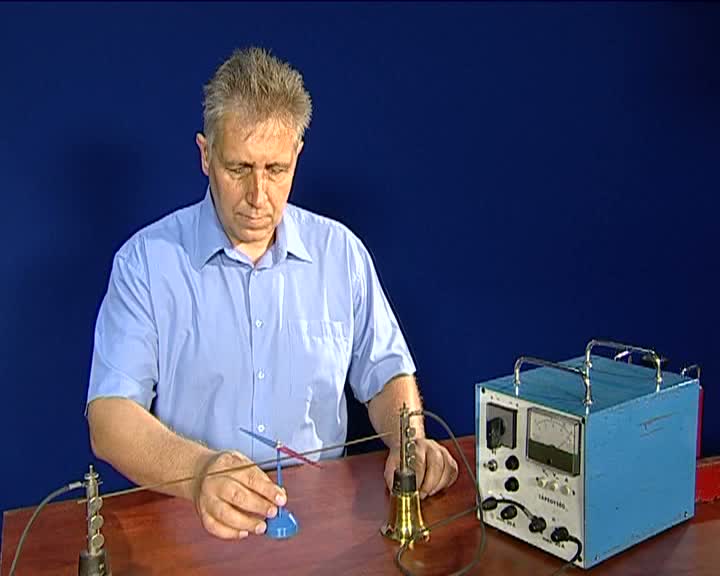„Áram mágneses tere, Oersted kísérlet” változatai közötti eltérés
| 8. sor: | 8. sor: | ||
== English text == | == English text == | ||
| − | For the Oersted experiment one needs a current source, a straight piece of conductor and a magnetic needle (compass). The turn of the compass indicates that the current generates magnetic field around the needle. By | + | For the Oersted experiment one needs a current source, a straight piece of conductor and a magnetic needle (compass). The turn of the compass indicates that the current generates magnetic field around the needle. By changing the direction of the current the compass will turn in the opposite direction. Keeping the direction and magnitude of the electric current unchanged the deflection of the compass above and below the conductor will be opposite. Question: What is there to indicate that the conductor is positioned in the north-south direction? |
== Fizikatörténet == | == Fizikatörténet == | ||
A lap 2013. április 5., 12:01-kori változata
Az elhangzó szöveg
Az Oersted kísérlethez szükségünk van egy áramforrásra, egy egyenes vezetőre, továbbá egy mágnestűre. A mágnestű határozott elfordulása jelzi, hogy az áram a vezető körül mágneses teret hoz létre. Az áram irányát megfordítva, az iránytű is ellenkező irányba fordul el. Az áram irányán és nagyságán nem változtatva, a mágnestű kitérése a vezető felett épp ellentétes irányú lesz mint a vezető alatti helyzetben volt. Kérdés: Mi mutat arra, hogy a vezető észak-déli irányban helyezkedik el?
English text
For the Oersted experiment one needs a current source, a straight piece of conductor and a magnetic needle (compass). The turn of the compass indicates that the current generates magnetic field around the needle. By changing the direction of the current the compass will turn in the opposite direction. Keeping the direction and magnitude of the electric current unchanged the deflection of the compass above and below the conductor will be opposite. Question: What is there to indicate that the conductor is positioned in the north-south direction?
Fizikatörténet
1820-ban egy dán fizikus Hans Christian Ørsted észrevette, hogy az árammal átjárt vezető közelében elhelyezett iránytű az áram hatására elfordul. Megállapította, hogy az elektromos áram mágneses teret létesít. (A mozgó töltések maguk körül mágneses teret hoznak létre.)
Kísérletünkben az árammal átjárt vezető észak-déli irányban van elhelyezve. Az áram bekapcsolásakor, az iránytű a Föld mágneses terének és az áram mágneses terének eredőjének irányába fog beállni.
Még ugyan ebben az évben ezt a jelenséget Jean Baptiste Biot és Felix Savart tovább kutatta és a jelenség kvantitatív leírását is megadta. A hatás gyenge volt, többen kísérleteztek a hatás felerősítésével. Először az áramerősség növelésével próbálkoztak, majd Johann Salomo Christoph Schweiggernek az az ötlete támadt, hogy ha ugyanazt az áramot többször egymás után vezeti el a mágnestű mellett, akkor az áram mágneses hatását megsokszorozhatja. Egy négyszögletes fakeretre szigetelt huzalt csévélt fel. Egy sokmenetű, négyszögletes tekercset kapott, amely belsejében összegződött az egyes menetek mágneses tere. Így már sokkal kissebb áramerősség is elegendő volt ugyanolyan mérvű iránytű elforduláshoz. Az árammal átjárt vezetőkeret mágneses tere merőleges a keret síkjára, tehát a legjobban akkor fejtheti ki a hatását az iránytűre, ha mágneses tere merőleges a Föld mágneses terére. Az áram bekapcsolásakor, a tekercs belsejében a mágneses tér a Föld mágneses terének és az áram mágneses terének vektori összege lesz.
Kísérleti elrendezés
A jelenség bemutatásához nagy áramerősség körülbelül 30-100 Amper erősségű áram szükséges. Ezért a bemutatás során a vezeték jelentősen melegedhet, esetleg látványosan füstölhet is.
Kapcsolódó oldalak
http://www.magnet.fsu.edu/education/tutorials/java/oersted/index.html
